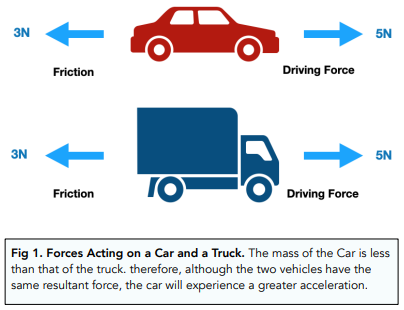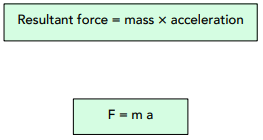Newton's Second Law (GCSE Physics)
Newton’s Second Law
Newton’s Second Law

In the previous tutorial we learnt that a resultant force means that an object is accelerating or decelerating. Newton’s Second Law helps us understand how we can measure the size of this acceleration or deceleration.
The size of the acceleration (positive or negative) depends on two factors:
- Resultant Force – The larger the resultant force, the larger the acceleration. Remember, if the resultant force is zero, the object is at constant speed and does not accelerate.
- Mass – the heavier an object is, the more force needed to accelerate it, and hence the lower the acceleration for a given resultant force.
For example, both vehicles below have a resultant force of 2N. The car is much lighter than the truck, so will experience a larger acceleration.

Relationships of Proportionality
In Newton’s Second Law, there are relationships of proportionality.
We know that the acceleration of an object is proportional to the force acting on it (as the force increases, the acceleration increases).
We also know that the acceleration is inversely proportional to the mass of the object (as the mass increases, the acceleration decreases).
Calculating Resultant Force
Formula for Resultant Force
We can calculate resultant force using the following formula.

Where:
- force, F, in newtons, N
- mass, m, in kilograms, kg
- acceleration, a, in metres per second squared, m/s²
Question: Calculate the mass of a spaceman who accelerates at 1.5m/s² when pushed with a force of 150N.
1. Write out the formula.
For this question, we want to rearrange the equation to find mass.
F = ma
m = F / a
2. Substitute in the numbers.
m = F / a
F = 150N, a = 1.5 m/s²
m = 150 / 1.5
m = 100 kg
Inertial Mass
We can use Newton’s Second Law to help us find a value for inertial mass. Since Newton’s Second Law is F = ma, we can rearrange this to give us m = F / a. This means that inertial mass can be defined as follows:
Inertial mass is the ratio of force over acceleration.
We can use the inertial mass to determine how ‘difficult’ it is to change the velocity of an object. The higher the inertial mass, the more difficult it is to change the velocity of the object.
Everyday Road Transport
You should know everyday speeds. Previously, we discussed some common forms of transport, such as cycling, walking and driving a car. You can find some average speeds in the table we outlined in the section on acceleration. Some exam questions my ask you to estimate the accelerations and forces involved with different forms of transport.
Approximations
You should be able to use the symbol ‘ – ’ when talking about ̴ approximations. It indicates to the examiner that the value you are giving is an approximate answer only.
Question: Estimate the force experienced by a cyclist and his bike when he accelerates from rest to a typical speed.
1. We know the average speed for a cyclist. From our table, we know that the average speed of a train is about 6m/s.
– 6 m/s
2. We can estimate the time taken to reach this speed. As an estimate, we could say that it takes about 12 seconds to reach this speed.
– 12 seconds
3. We can work out the acceleration. Using the speed and time, we can work out the acceleration of the cyclist.
Acceleration = change in velocity / time taken
Acceleration = 6 / 12
Acceleration = 0.5
4. Estimate the mass of the cyclist. We can estimate the mass of the cyclist with his bike may be around 90kg.
– 90 kg
5. We can use the formula. Now we can use the formula F = ma to find the force on the cyclist (plus his bike).
F = ma
F = 90 x 0.5
F = 45N
Investigating Force and Acceleration
We can investigate the acceleration of an object using the following method. In one experiment, we will be changing the mass of the object, whilst in the other we will change the force applied to the object.
Method 1: Changing the mass
- Gather all the equipment. For this experiment, you will need a motion sensor (attached to a computer), a small trolley, a newton-meter, some masses and a piece of card.
- Set up the equipment. Place the card onto the trolley. Make sure that the motion sensor is attached to the computer. Also, ensure that the newton-meter can be attached to the trolley and used to pull it along.
- Pull the trolley. Using the newton-meter, apply a constant force to the trolley and pull it away from the motion sensor. The motion sensor will record the velocity and time taken for this to happen. From this data, we can calculate an acceleration.
- Change the mass. Add on a mass and then repeat step 3. Make sure that the force is kept constant. The motion sensor will have recorded the new velocity and time taken, so we will have a new acceleration.
- Repeat step 4. Now, keep adding masses one by one onto the trolley. Make sure that the force is kept constant. Do this at least 7 times to get a complete set of results.
- Record the results into a table. You can record your results into a table as shown below.

Method 2: Changing the force
- Gather all the equipment. For this experiment, you will need a motion sensor (attached to a computer), a small trolley, a newton-meter and a piece of card.
- Set up the equipment. Place the card onto the trolley. Make sure that the motion sensor is attached to the computer. Also, ensure that the newton-meter can be attached to the trolley and used to pull it along.
- Pull the trolley. Using the newton-meter, apply a constant force to the trolley and pull it away from the motion sensor. The motion sensor will record the velocity and time taken for this to happen. From this data, we can calculate an acceleration.
- Change the force. Using the newton meter, pull the trolley with more force and then repeat step 3. Make sure that the mass is kept constant. The motion sensor will have recorded the new velocity and time taken, so we will have a new acceleration.
- Repeat step 4. Keep increasing the force on the trolley in small increments. Make sure that the mass is kept constant. Do this at least 7 times to get a complete set of results.
- Record the results in a table. You can record your results into a table as shown below.





Still got a question? Leave a comment
Leave a comment